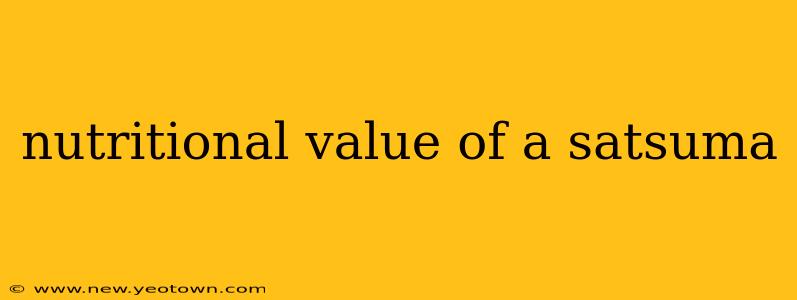The humble satsuma. This easy-to-peel citrus fruit, often found nestled in grocery store bins during the fall and winter months, is more than just a convenient and delicious snack. It's a nutritional powerhouse packed with vitamins, minerals, and antioxidants that contribute to overall health and well-being. Let's peel back the layers and explore the surprising nutritional value hidden within this small but mighty citrus fruit.
My grandmother, a woman who understood the power of simple, wholesome foods, always kept a bowl of satsumas on the kitchen table. She'd hand them out like little treasures, a burst of sunshine on a chilly afternoon. It wasn't until later in life, when I delved into nutrition, that I truly understood the wisdom behind her simple act.
What are the key nutrients in a satsuma?
Satsumas are low in calories but surprisingly rich in essential nutrients. A single medium-sized satsuma (approximately 80 grams) provides a good source of:
- Vitamin C: A powerful antioxidant that supports immune function, protects against cell damage, and aids in iron absorption. Satsumas are a fantastic source, providing a significant portion of your daily recommended intake.
- Fiber: Essential for digestive health, regulating bowel movements and promoting satiety. The fiber in satsumas contributes to a feeling of fullness, helping with weight management.
- Potassium: An important electrolyte that helps regulate fluid balance, blood pressure, and muscle contractions.
- Other Vitamins and Minerals: While less abundant than Vitamin C and fiber, satsumas also contain smaller amounts of Vitamin A, folate, and thiamine. These nutrients contribute to various bodily functions, from vision health to energy production.
Are satsumas good for your health?
The health benefits of satsumas extend beyond their impressive nutrient profile. The antioxidants present in satsumas, particularly Vitamin C and other flavonoids, help protect your cells from damage caused by free radicals – unstable molecules linked to aging and chronic diseases. This antioxidant power contributes to:
- Improved Immune Function: The high Vitamin C content strengthens the immune system, helping your body fight off infections.
- Reduced Risk of Chronic Diseases: Studies suggest that regular consumption of fruits rich in antioxidants like satsumas may help reduce the risk of certain chronic diseases, including heart disease and some types of cancer. However, it's important to remember that this is part of a balanced diet and lifestyle, not a cure-all.
- Improved Digestive Health: The fiber content promotes healthy digestion and helps prevent constipation.
- Enhanced Skin Health: Vitamin C plays a vital role in collagen production, contributing to healthy skin.
What are the benefits of eating satsumas daily?
While there's no magic bullet for perfect health, incorporating satsumas into your daily diet can offer several advantages. A daily satsuma can contribute to a more vibrant immune system, aid in digestion, and provide a boost of essential vitamins and minerals. Their ease of consumption makes them a perfect on-the-go snack, ensuring you get your daily dose of fruits and vegetables.
How many satsumas should I eat a day?
There's no strict limit, but as with any fruit, moderation is key. One to two satsumas a day is a reasonable amount for most people. Listen to your body – if you feel satisfied after one, that's perfectly fine!
Are there any side effects of eating too many satsumas?
Consuming excessive amounts of satsumas could lead to digestive upset due to their high fiber content. Additionally, the citric acid in satsumas can potentially erode tooth enamel if consumed excessively. Rinsing your mouth with water after eating satsumas can help mitigate this effect.
What are the differences between satsumas and other citrus fruits?
While satsumas share similarities with other citrus fruits like oranges and mandarins, they are unique in their seedlessness and easy peeling. Their sweetness and slightly milder flavor profile also distinguish them. They are often considered a sweeter and less acidic option compared to some other citrus fruits.
My grandmother's simple act of offering a satsuma remains a potent reminder of the power of simple, wholesome foods. So, next time you see a satsuma, remember its nutritional value and the delightful burst of flavor and health it brings. It’s more than just a fruit; it's a little piece of sunshine, packed with goodness.

